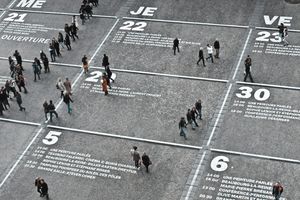Paul Ricoeur’s mimetic narratology sees three moments in narratives. Mimesis 1, prefiguration, is the first moment, all about our pre-existing experience and our expectations.

How can a story-teller start to tell a story?
How can an audience or reader of a story begin to engage with the story being told?
What is happening, indeed what has happened, before the story is even told?
Whatever else may be going on in the composition or reception of a plot, the experience of it is grounded in the real world, the world of action, of structures, of symbols and of temporality. Narratives describe something recognisable by comparison with the real world, and a story’s world-like features are described in the plot (rather than deduced).1
Paul Ricoeur argues that, if this is true, three things must exist for mimesis 1, prefiguration, to function.
Narrative Competence
Firstly, the composer or audience must have existing experience in order to recognise descriptions of world-like features; in other words, ‘if it is true that plot is an imitation of action, some preliminary competence is required: the capacity for identifying action in general by means of its structural features.’2
Secondly, a further level of competence is required: ‘an aptitude for identifying … the symbolic mediations of action.’3
And thirdly, the symbolic features are wrapped in temporal elements, ‘from which proceed more directly the very capacity of action to be narrated and perhaps the need to narrate it.’4
A competence in recognising and working with these three — the structural, the symbolic and the temporal — provides the basis for narrative competence, a necessary quality for narration.
Narrative competence is, of course, a dynamic, not static, quality: one does not ‘arrive’ at competence but rather continues to develop and extend one’s competency as one is persistently exposed to stories — stories of all kinds, narratives of all types.5 Ricoeur’s view is not limited to merely ‘literary’ stories here. Every form of story helps progress one’s narrative competence, from someone recounting a memory or relaying the story of their day at work, through newspaper accounts, movies, video games, social media posts, non-verbal stories, all the way through to the more orthodox form in published books. All exposure to narrative and narrativity develops one’s narrative competence.

Rather than defining action in a narrow sense — i.e. as what someone does — Ricoeur acknowledges that action is always bound within a broader structure of concepts that distinguishes action from mere physical movement. Actions have goals, goals which are anticipated and which have results. But actions toward goals imply motives, the reasons for engaging in the actions that allow one event to be connected to another. These motives are held by agents who are culpable for the consequences of their actions, and consequently a network of interactions is constructed, each item complementing the other.
These elements, and more besides, allow narrators and listeners to answer questions like ‘what’, ‘why’, ‘who’, ‘how’, ‘with whom’ and ‘against whom’ with regard to any action.6 By invoking any one of these terms, moreover, it is possible and even necessary to link that term to any or all others in this network of narrative actions. Mastering the network as a whole and each element within it ‘is to have that competence we can call practical understanding.’7
This practical understanding is necessary for a theory of narrative for two reasons. Firstly, a familiarity (frequently subliminal) with the elements of the network, through concepts such as agent, goal, situation, help, opposition, conflict, success, failure and so on is presupposed in any narrative.8 Secondly, narrative is not limited to a familiarity with the conceptual network of actions, but also includes discursive and analytic elements that elevate it from a mere sequence of actions and give it a transformative capacity.
Narrative competence therefore requires a familiarity with the (unwritten) rules that determine the diachronic composition of a plot, i.e. how the plot evolves, how the story develops through time. These two together — a relation of presupposition (the action-terms) and a relation of transformation (the rules of emplotment) — are fundamental for narrative competence, argues Ricoeur:
‘[t]o understand a story is to understand both the language of “doing something” and the cultural tradition from which proceeds the typology of plots.’9
With these two in synchrony one is able to engage with the structural dynamics of narrative.
The Symbolic

Ricoeur’s second essential dynamic in developing narrative competence is concerned with the symbolic dimension. Symbolism is elemental to Ricoeur’s hermeneutic philosophy, his philosophy of interpretation, especially so in the field of narrative.
‘If, in fact, human action can be narrated it is because it is always already articulated by signs, rules and norms. It is always already symbolically mediated.’10
Ricoeur prefers to speak of ‘symbolic mediation,’ rather than simply of symbols, in order to distinguish, amongst cultural symbols, those that underlie action and give it its primary signification before it becomes detached from the practical level.11
Symbolic mediation creates a network of interacting symbols, expanding from the specific act, through the ritual and the system of behaviours up to ‘the whole set of conventions, beliefs, and institutions that make up the symbolic framework of a culture.’12 This then provides the symbolic context within which an action is situated, and subsequently through which an action can be interpreted.
The same gesture of raising one’s arm, depending on the context, may be understood as a way of greeting someone, of hailing a taxi, or of voting. Before being submitted to interpretation, symbols are interpretants internally related to some action.13
As a result of this context-making function, symbols enable actions to be ‘readable’. In other words, symbolic mediation creates the cultural rules of meaning by which an action can be interpreted. To be clear, these rules are not the rigid laws of science but the adaptive norms of a culture.14 Nonetheless, they powerfully shape the interpretive realm that actions inhabit.
One of the qualities of cultural norms is that they allow an action to be qualified or measured against them, evaluated against some moral scale and so given a relative value: this action is preferable to that one because it has a greater moral value in this cultural context. This is, of course, not limited to the actions themselves but can extend to any element in the narrative structural network — the goals, motives, agents, and so on — allowing them to be called, for example, ‘good’ or ‘bad’.15
Moreover, this moral quantifying is inevitable, and every action or agent is praised or condemned, overtly or not, in the development of a plot.
‘There is no action that does not give rise to approbation or reprobation, to however small a degree, as a function of a hierarchy of values for which goodness and wickedness are the poles.’16
The morality of the actions or actors may as much praise or condemn (or indeed celebrate, compliment, parody, satirise or denigrate) the morality of the culture in which they find themselves as be praised or condemned.
Poetic composition creates an ‘ethical laboratory’ that allows the poet to experiment with the values and morals of a culture.
In this sense, poetic composition creates an ‘ethical laboratory’ that allows the poet to experiment with the values and morals of the culture in which the work is situated (and ‘poet’ here is a poetic designation for any creative writer, of course). Thus, the symbolic aspect of narratives gives rise to morally ambiguous, complex or conflicted characters, such as, say, Shakespeare’s Hamlet, Mr Rochester in Jane Eyre, Han Solo in Star Wars, Batman in The Dark Knight, or, in my particular field, Peter in the Biblical Gospel narratives of Jesus’ arrest. Examples are, of course, endless.
Symbolic mediation injects the ethical dimension into narrative competence.
The Temporal

The third element concerns the temporal dimension within which narrative time is situated. I shall discuss the question of time in more detail in a separate post, but a brief discussion is warranted at this stage.
Ricoeur defers the opportunity to define what he believes is a relatively simple correlation between the components of the conceptual network of action just described and the components of a concept of time, or for discussing the possibility of a pre-narrative structure of experience, in preference for an analysis of the human experience of living within time.17
Ricoeur is impressed by Augustine’s response to the problem of describing time. Rather than speaking of time as a series of moments moving from the future, through the present and into the past, Augustine postulates that time has a threefold present: there is a present of future things; there is a present of present things; and there is a present of past things.18
The present contains an anticipation of what is to come, a memory of what has just passed, and the experience of what is presently occurring, all equally present, all necessarily present.
Ricoeur notes that there is some kinship here with Heidegger’s notion of within-time-ness — time is that within which we ordinarily act.19 This is an apt description of his own argument for a temporality of action, for example, and the experience of this within-time-ness, or being-within-time as Ricoeur offers, is a pre-condition for narrated time.20
With Heidegger’s approach, temporality is the root form and most authentic experience of time, and in this form is portrayed as coming to be, having been and making present.21 In this dialectic the words ‘past’, ‘present’ and ‘future’ evaporate as time itself is ‘desubstantialised’ into ‘the exploded unity’ of the three temporal forms.22 This is the temporal instantiation of Heidegger’s notion of Care; the grounding of being is in temporality.23
Drawing more heavily on Heidegger, Ricoeur argues that it is through the embodiment of being-within-time in language that temporality cannot be simply reduced to the representation of linear time.24 It is ‘something other than measuring the intervals between limit-instants.’25 Being-within-time also incorporates a ‘reckoning with time,’ and as a result ‘we must have recourse to meaning, not vice versa.’26
By having recourse to public language that describes things within-time (then, after, later, since, when, until, now that, etc.), we are able to reckon with time and talk publicly of the time of preoccupation.
In other words, being-within-time is the beginning of being able to narrate.
In breaking with the linear representation of time — a simple succession of nows — it is possible to start on the path of narrative configuration, and to see a connection between the realm of narrative and being-within-time.
Gaining Competence
The first stage of mimesis, mimesis 1, cannot be underestimated. To have the required competence with narrative, familiarity with the semantic structures, symbolism and temporality of the narrated human condition is vital. The act of emplotment is predicated on this preunderstanding, and the richer the preunderstanding the richer the encounter with the plot.
The sheer volume of narratives in everyday life is so vast that every person is schooled in the ability to discern and weigh stories from their first moment.
Ricoeur’s analysis does little to describe the genesis of this narrative competence.27 His repeated shorthand of, for example, ‘poets and their readers’28 does not indicate whether he has in mind only skilled narrative composers or audiences, the literary or academic elite, say, or whether he is describing ordinary human experience. However, the sheer volume of narratives in everyday life is so vast that every human being is schooled in the ability to discern and weigh stories from their first moment.
From our earliest years as children we are told stories, beginning our lifelong education in narrative. From the mundanities of ‘how was your day?’ or ‘what are you up to this weekend?’ to the more formal narratives of books, newspaper articles, films, television programmes, computer games or plays, or the challenge of a job interview or recounting one’s personal formation, say, the human world is saturated with emplotment.
Each encounter with a story being told extends and redefines one’s previous experiences of narrative.
Each recital shapes and reforms what makes a ‘good story,’ what makes a story believable and what does not.
Each performance increases one’s capacity to receive a narration.
Each rendering teaches us more about selecting (or excluding) events and (re)describing actions.
As humans, our prefiguration is constant, overt and subliminal, unavoidable and utterly innate. Human beings narrate. We are shaped by every story we hear.
We cannot avoid it.
Photo credits
Benny Jackson on Unsplash
Sebastián Villegas on Unsplash
Dora Reis on Unsplash
Curtis MacNewton on Unsplash
Footnotes
-
Paul Ricoeur, Time and Narrative, vol 1., (Chicago and London: University of Chicago Press, 1984), 54.
-
Ricoeur, Time 1, 54, emphasis mine.
-
Ricoeur, Time 1, 54, emphasis mine.
-
Ricoeur, Time 1, 54.
-
Cf. David Herman, ‘Scripts, Sequences, and Stories: Elements of a Postclassical Narratology,’ PMLA 112.5 (1997): 1053–57 (1046–59).
-
Ricoeur, Time 1, 55.
-
Ricoeur, Time 1, 55.
-
Ricoeur, Time 1, 55–56.
-
Ricoeur, Time 1, 57.
-
Ricoeur, Time 1, 57.
-
Ricoeur, Time 1, 57.
-
Ricoeur, Time 1, 58.
-
Ricoeur, Time 1, 58.
-
Ricoeur’s understanding of the ‘rules’ of narrative here are substantially and importantly different from the rules defined by structuralist narratology preferred by the likes of Vladmir Propp, Tzvetan Todorov, Roland Barthes, Algirdas Greimas and more recent proponents, like Joseph Campbell, Christopher Vogler and followers of writing systems like Story Grid. Ricoeur’s ‘rules’ of narrative are fundamentally different in that they are evolutionary, culturally-defined and culturally-bound rules, rather than the quasi-scientific rules of semiotic and structuralist theories of narrative.
-
Ricoeur, Time 1, 58.
-
Ricoeur, Time 1, 59.
-
Ricoeur, Time 1, 59–64.
-
Ricoeur, Time 1, 60.
-
See a future post for a critical examination of Ricoeur’s understanding of Heidegger’s understanding of time.
-
Ricoeur, Time 1, 61. ‘Being-within-time’ is the beginning of Ricoeur’s narrative-shaped riposte to Heidegger’s notion of ‘being-towards-death.’ Cf. Ricoeur, Time 3, 272.
-
Ricoeur, Time 1, 61.
-
Ricoeur, Time 1, 61.
-
Cf. Clark, Paul Ricoeur, 169–70.
-
It should be noted, of course, that Heidegger’s notion of being and time and Ricoeur’s own are importantly different (see the future post indicated at n.19 above). The central place of Heidegger’s notion of being-towards-death gives his position an overtly future-oriented attitude, which Ricoeur refuses to follow. Nonetheless, Heidegger’s progress on the question of time is a virtuous detour for Ricoeur to pursue at this stage. For his more thorough analysis of Heidegger’s Being and Time, see Ricoeur, Time 3, 60–96.
-
Ricoeur, Time 1, 62.
-
Ricoeur, Time 1, 62.
-
However, for an account of the development of narrative competence analysed through developments in cognitive science see Herman, ‘Scripts,’ 1053–57 and future posts.
-
Ricoeur, Time 1, 64.